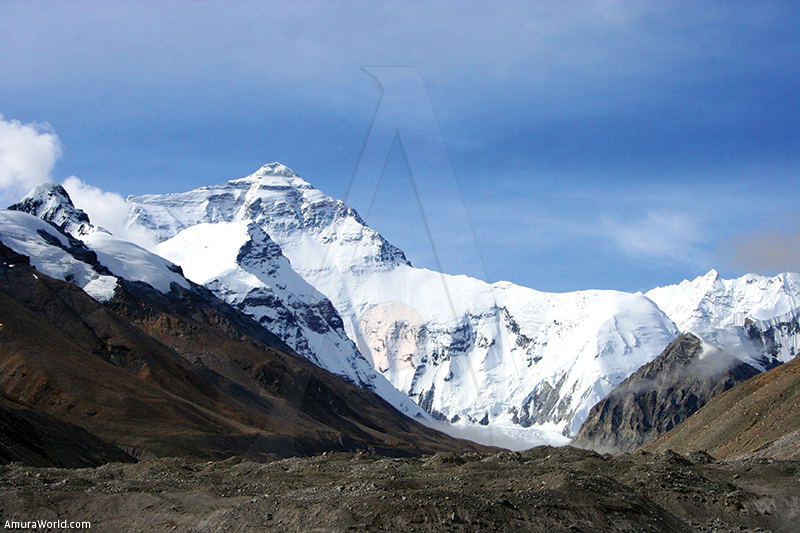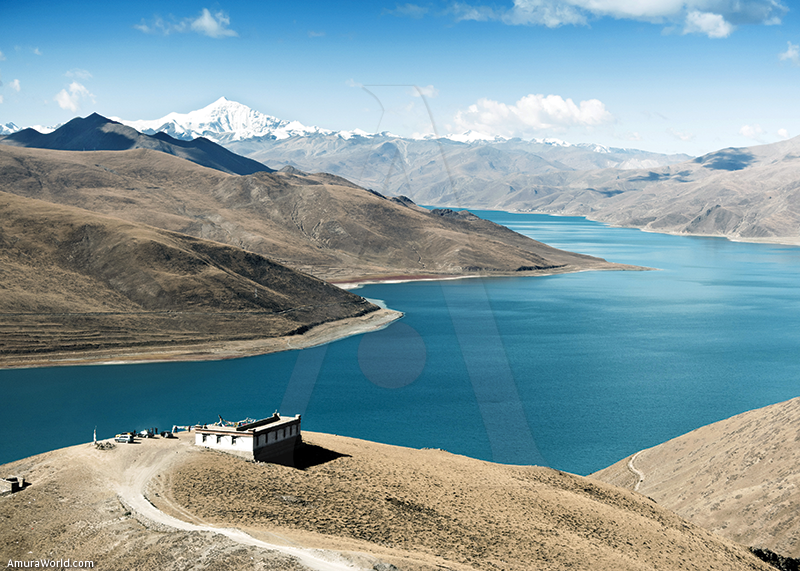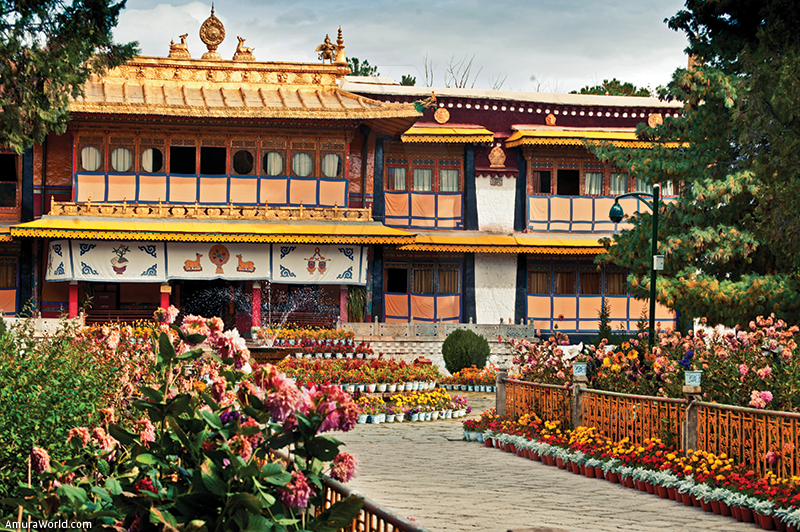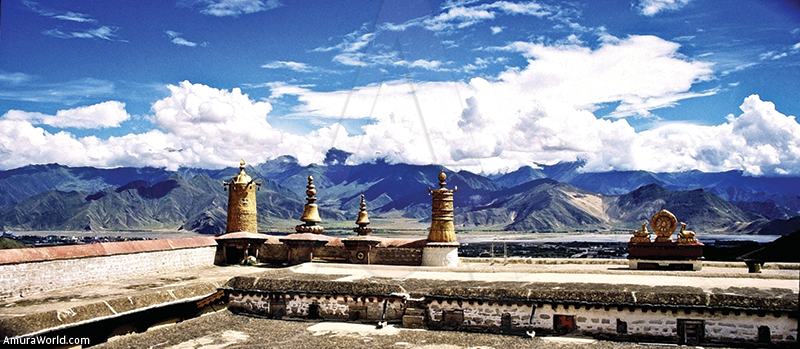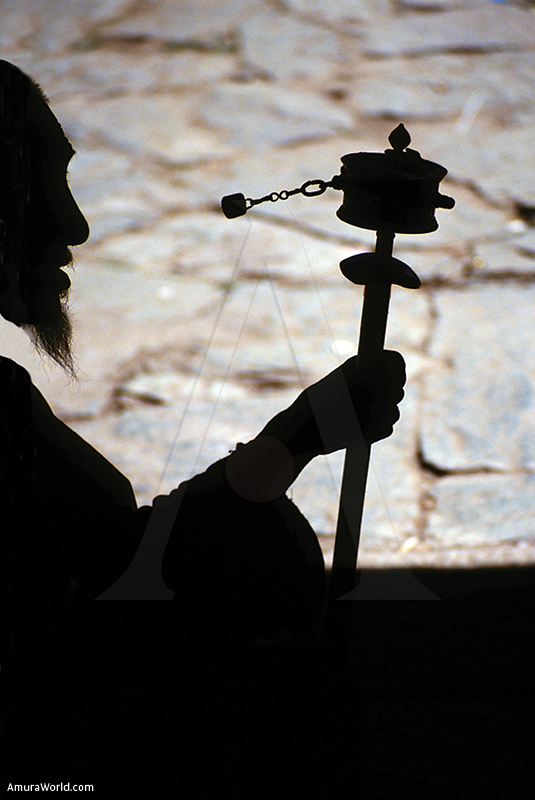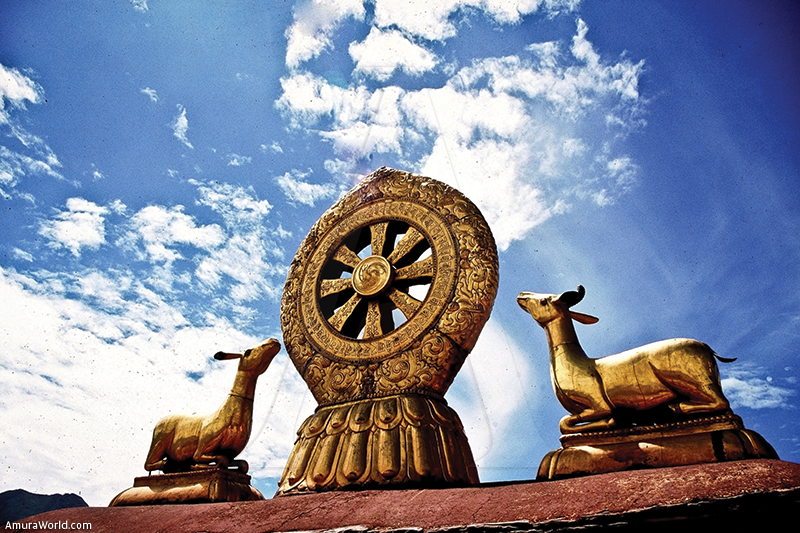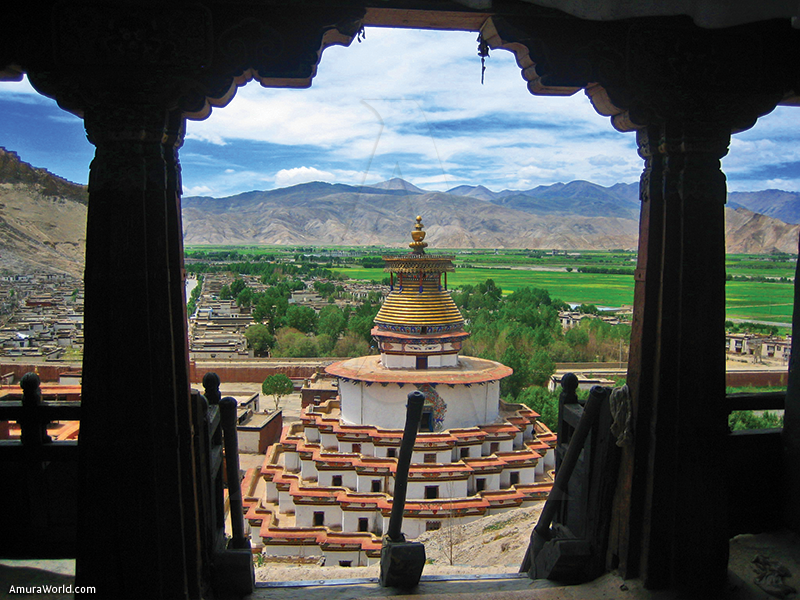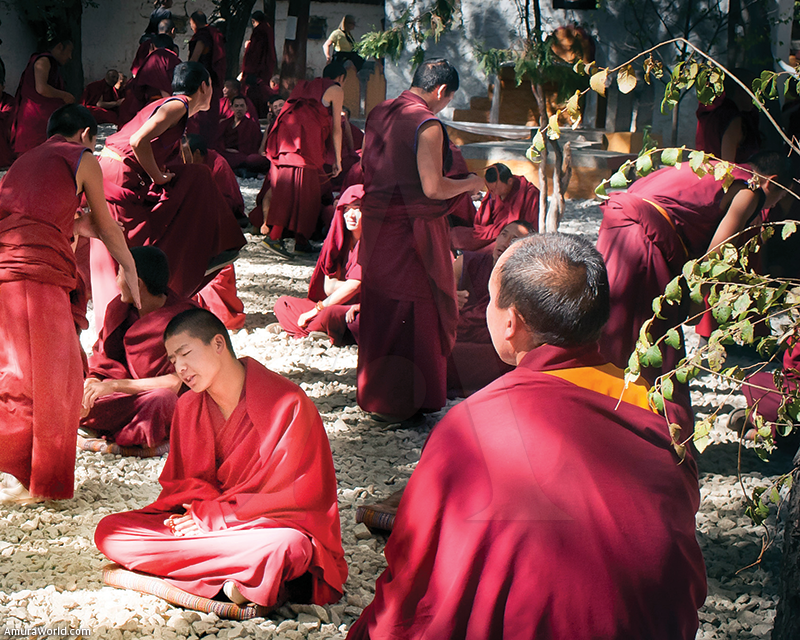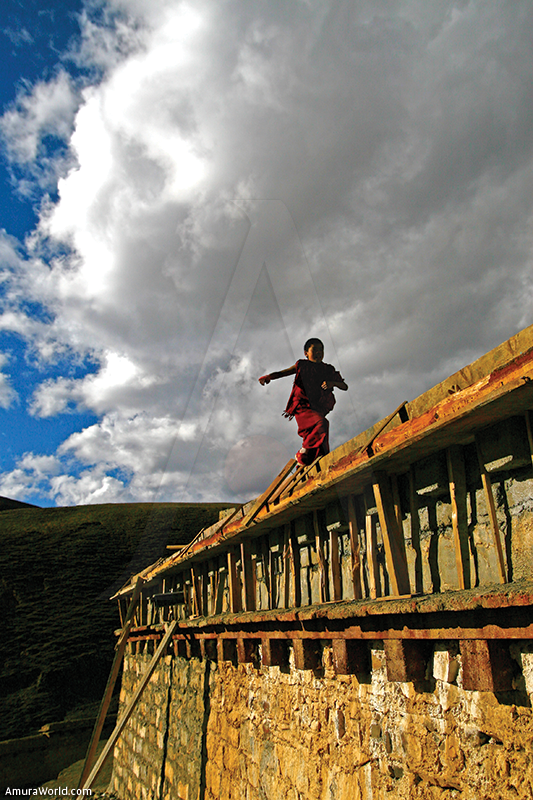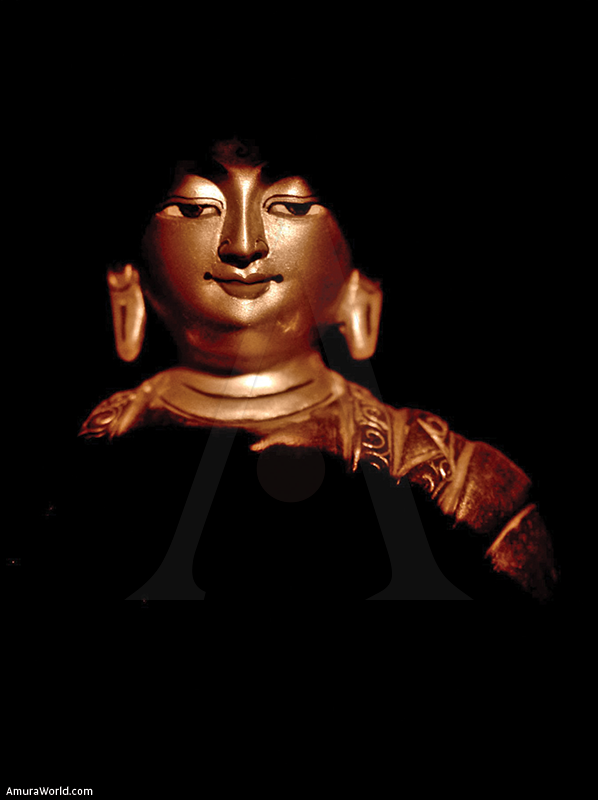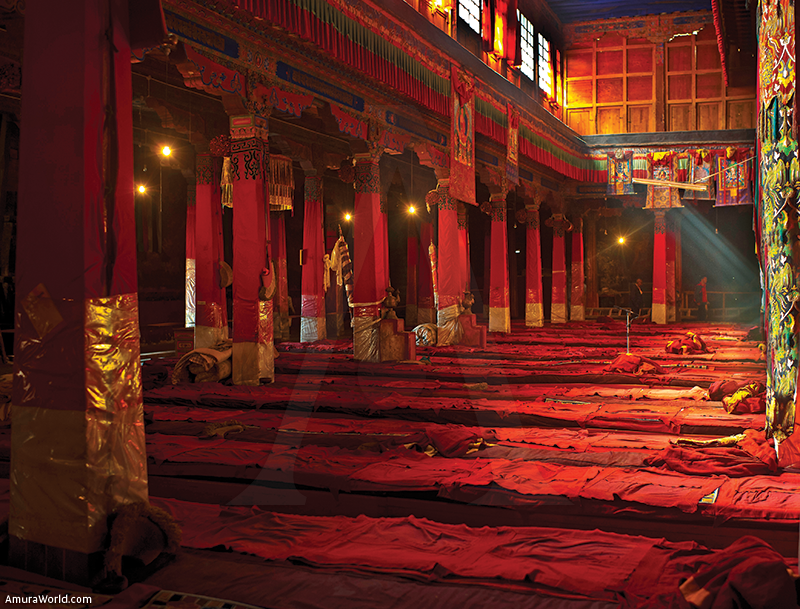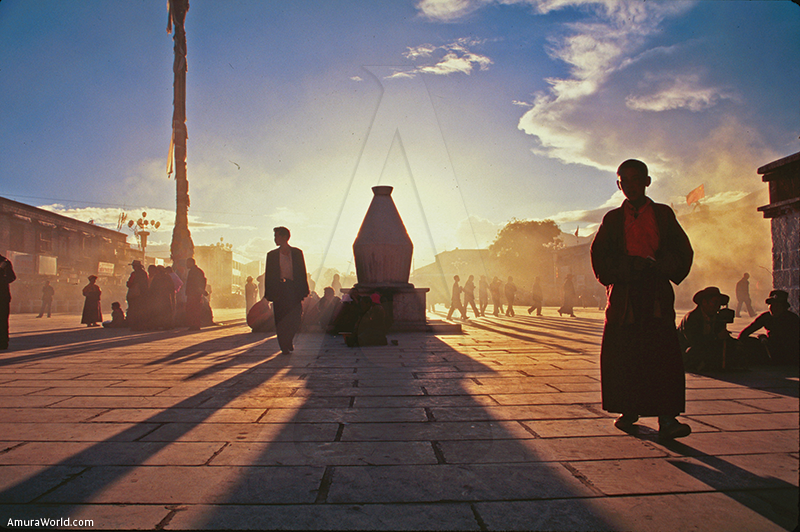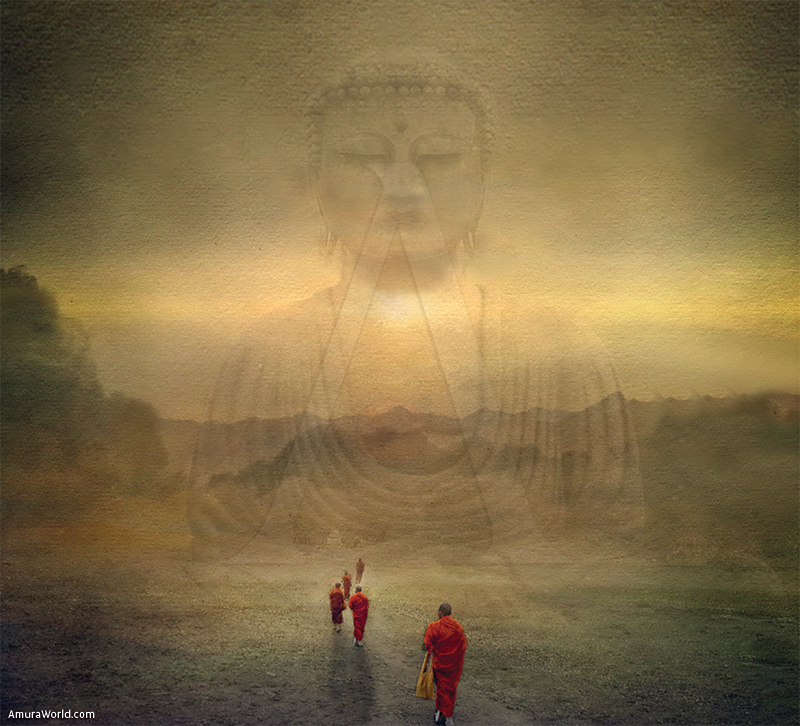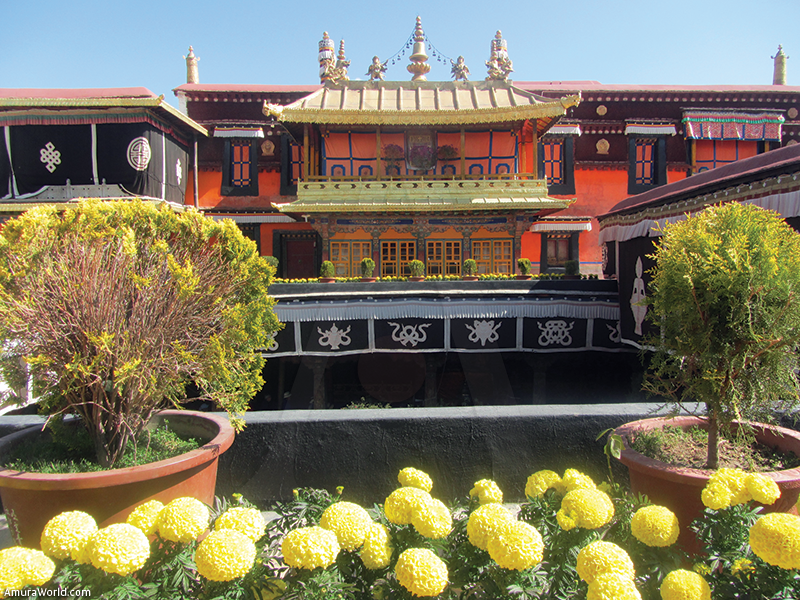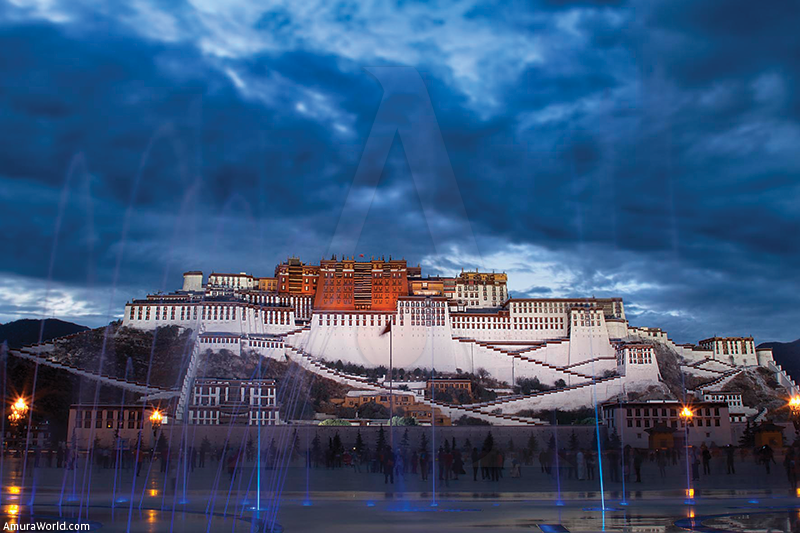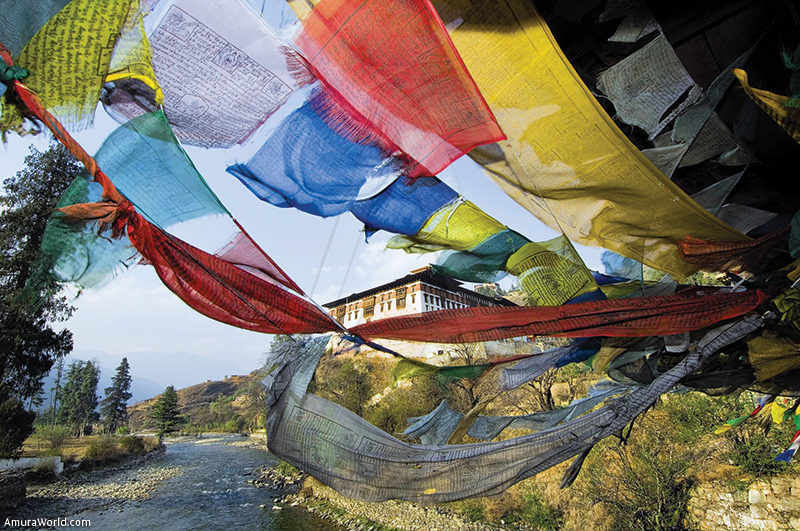The Third Pole
A legend tells us that before history, monkeys lived with other animals in the forest near the Yarlong Yangbo River, they ate fruits. Their body structure and habits made them go to the prairies. They walked erect and they covered their chest with leaves and eat seeds. They manufactured stone tools and evolved into the primitive ancestor of the Tibetans.
The oldest human remains from Tibet are dated 10,000 years BC. It was only 2.200 years ago when Tibet began to figure in the history of Asia. This epic can be divided into prehistory, the 30 king’s dynasty, the arrival of the Mongol Empire, the Chinese Empire, independent Tibet and its incorporation into the Popular Republic of China.
MOUNTAINS
Mountain ranges kept the Tibetan people isolated, allowing them to perfect solitude to develop their spiritual tradition. The average altitude of Tibet is 4,000 meters above sea level, and it shares with Nepal the Everest (8,848 m), which is known there as Sagarmatha (“The front of heaven”) and in Tibet Qomolangma Feng (“Mother of the Universe”) .
Some of the birds that can rise to the highest altitudes are the geese. You can find them, flying over Everest over 9,000 m. Heading up the mountain to where their wings allow them to, looking for an updraft that drives them to fly over the top, if not found, return and await another opportunity to make the trip.
GEOGRAPHY AND ECOSYSTEM
The historic Tibet extends through 2’250, 000 km2, with an average elevation is 4,900 meters and a population of about 6 million Tibetans. The current Autonomous Region covers 1’228, 400 km2 and its average elevation is 4,000 meters.
Tibetans call their country “Pho”, a word that Arabs and Persians carried to Europe as Tibbat and resulted later in Tibet. Tradition believes that borders with Kashmir to the west, with China to the east, with Mongolia and Turkestan to the north, and with Nepal and India to the south. The current political division differs from that boundary, as shown on the map (p. 57).
Tibet is called the Third Pole because it keeps about a third of the world’s fresh water through its massive glaciers. Melting snow and ice lead to four major rivers, the Yangtze, Mekong, Indus and the Brahmaputra (6.300, 4.880, 3.180 and 2.900 Km respectively). It also forms huge lakes in the high plateau including 24 with an area greater than 200 km2; the largest is Lake Nam, with 1961.5 km2.
CULTURE
The Tibetan culture is its religious tradition. It was here where the Buddhist classical civilization was guarded when it disappeared from its native India, due to the Islamization of the country. Buddhism then fled into Tibet, where it still remains.
The Tibetan tradition places the spiritual and political authority in the hands of a single person, by establishing the link between spirituality and community life. The task falls to the Dalai Lama (Dalai, “ocean” and Lama, “guru”: Guru big as the ocean).
The written tradition of Tibet is abundant. The Derge Printer retains 270.000 xylographic printing plates, some very old, preserving the teachings of the most revered Buddhist teachers. It functions since 1729.
Tibetans have historically considered spirituality their greatest treasure. They have feared, in light of what happened to India, that openness may imply the loss of their culture. Today, as a result of political and social circumstances, Tibetan culture is going through a rapid process of change.
HOW TO GET TO TIBET
Official data from the Chinese government reported that the number of travelers to Tibet has increased in ten years more than 11 times fold, a staggering 1,126%. International travelers are interested in Buddhist traditions or want to interact with Tibet’s prodigious nature. The Himalayan ecosystem of the area is enormously attractive. It is also being visited because it is a distant exotic destination, and there are those who seek to add it to their bucket list of places visited around the world.
Flights to and from Tibet have a quirk. From the Americas you fly over the Pacific to the west, in the opposite direction to the Earth’s rotation to shorten the distance. Returning you must fly over the North Pole or near it, via New York or Vancouver.
The opening of Tibet to the international traveler came in the early eighties, at the end of the political process of the times. As it happens with any cultural assimilation, with globalization comes to Tibet a modernity that significantly disrupts the native civilization. During this opening there has been periods in which Tibet is closed.
A radical change came when the Chinese government completed the marvelous feat of engineering that is the railway that connects Xining Qingzang with Lhasa. It mobilizes more than 5000 visitors per day, with tourists and travelers from China seeking to settle there. Supplies now come easily to industry, trade, services and tourism.
In the nineties, the Holiday Inn Lhasa was built, but the lack of transportation prevented it from obtaining the necessary supplies to operate. The hotel could not be sustained in the 5 star range; it was closed and became a modest hotel. Today there are several international hotel chains as well as Chinese and Tibetan low budget small hotels which are clean, functional and economical.
Anyone visiting Tibet will never forget the experience. It will get you close to its nature, its culture and clean air. The Tibetan transparency of the atmosphere allows a visibility of many miles; it seems that things are closer, although they are very far away. The optical illusion is due to the thinness of the atmosphere: at this point the air acquires a clarity that shows in the pictures.
For those who have the concern of learning meditative techniques or the religious principles or the pure Tibetan culture, should visit a Tibetan community outside of Tibet. In India the monasteries offer meditation seminars, teachings, retreats, etc., activities that do not exist in Tibet
Cultural Heritage and Living Patrimony.
There is no place on earth that resembles Tibet. For centuries this corner of the planet was protected from foreign curiosity by a veil of mystery and legends. Few adventurers undertook the difficult and eventful journey over the Tibetan plateau. Even today, only a few get to go into the “land of eternal snow.”
Tibet, known as the “Roof of the World”, is located in the heart of Central Asia, in the most extensive high plateau in the world. During the summer, its plains are covered with grasslands and wildflowers, while during winter, all life lies waiting for the warmth of spring. Its geography and natural beauty make Tibet one of the most beautiful regions of the planet.
It seems difficult to understand how man can live in such high altitudes. However, for over 5,000 years Tibetans have inhabited this region. Their lives, physically and spiritually marked by harsh environmental conditions, are inspired by a deep desire to live, a love and respect for the land and a great devotion to their religion and customs.
Definitely, the most fascinating aspect of Tibet is its culture, which extends into the distant past and is an interesting and original fusion of religion, politics and society.
Unfortunately, since Tibet began to come into contact with the rest of the world, the vast majority of its art, literature and architecture treasures have been lost. With this influence, even the future of the unique Tibetan way of life seems destined to change after centuries of isolation and preservation at the same time.
THE TIBETAN PLATEAU
The historic Tibet covers an area of approximately 2.5 million square kilometers, slightly larger than Mexico. Its average elevation above sea level is 4,000 meters. At this point, the transparency of the air virtually shortens distances, the sky has a deep blue, the sun’s rays are projected harder and the clouds seem closer.
Tibet is surrounded by high mountain ranges. To the south, it has the Himalayas, with the highest peaks in the world, which separates the Tibet region from India, Nepal, Bhutan and Myanmar. To the west, there are the Karakoram separate Tibet from Kashmir, Pakistan and Russia. And to the north, the Kunlums separate Tibet the region from mainland China.
Tibet is called “The Third Pole” due to its massive glaciers. It is the cradle of the major rivers in Asia, the Brahmaputra, Indus, Salween, Ganges, Yangtze, the Yellow River and the Mekong.
Due to its high altitude, Tibet has an extreme climate. In the mountains icy winds lash temperatures down to -40 degrees. In the valleys the weather is nice and warm most of the year, as well as in the capital city, Lhasa.
Within this vast territory , mostly arid, we can find climates from subtropical in the east where rice, bananas, peanuts and tea are grown, to the fertile moderate climate valleys of central Tibet, which are characterized by the production of potatoes, barley, oats, tomatoes and corn.
HISTORY
The written history of Tibet begins in the VII Century with the great and unifying King Tsong Tsen Gampo, an important figure in the history of the “Roof of the World” for having extended the Tibetan domain to the gates of the Chinese Tang imperial capital. He was also responsible for having entrusted the adoption of an alphabet for the Tibetan Sanskrit and for bringing Buddhism from the Indian subcontinent shortly before it disappeared from Hindustan.
In the thirteenth century, after hundreds of years of Buddhist cultural expansion, the Mongols took the protection of Tibet and instituted in 1578 Sonam Gyatso as the first Dalai Lama, which is the person officially invested with the political and religious power in Tibet. The title comes from the Mongolian word “Dalai,” ocean, and the Tibetan “lama” meaning guru or spiritual teacher.
Over the centuries, due to geographical isolation, to the royal patronage to the civilizing impulse of Buddhism and to the great willingness of the Tibetan people, Buddhism reached the highest development in its history. Tibet tried to approach the ideal state of a society ruled by philosopher kings and devoted entirely to personal development. Some have even said that in the time of their isolation, the gross national product of Tibet was their interior lighting.
During the prolific period of the VII to the XIX century, huge monasteries and impressive university towns were built, which functioned as commercial, political and cultural centers, all revolving around the lives of the Tibetan people.
In 1645, the Fifth Dalai Lama, Ngawang Lobsang Gyatso, undertook the construction of one of the most famous buildings in Asia, the Potala Palace. It is a monastery, the seat of government and the residence of the Dalai Lamas. It houses more than 15 chapels and 3000 rooms. The Great Fifth, as the Tibetans call him, implemented a system of government which lasted until the first half of last century.
The last of the Dalai Lamas, Tenzin Gyatso, left Tibet for political reasons and lives in Dharamsala, India. He is the fourteenth incarnation of the Principle of Universal Compassion.
THE PEOPLE
Nearly six million Tibetans live in Tibet. Most are engaged in agricultural work concentrated around the fertile valleys irrigated by waters and rivers formed by melted snow and ice. Other groups live in cities like Lhasa, Shigatse and Gyantse, where they develop business, crafts or industrial activities. Finally, an important segment of the population consists of nomadic Tibetan dedicated mainly to grazing yaks and goats, essential to the economy of Tibet.
The Tibetan ethnic, Mongolian and relative of the Burmese, has developed over time its own character and appearance. Their features are prominent cheekbones; dark hair and great physical strength in addition to a heritage of common cultural religious and linguistic diversity, have led this people to a unique high level of civilization.
In the last twenty years, more than 7 million from the rest of China have come to Tibet. This has gradually turned the Tibetan population into a minority within their own territory. As a result, better job opportunities, housing and health services have been allocated to this new population of internal migrants, who often stay there only temporarily.
FAMILY AND DAILY LIFE
As in the Hispanic world, family occupies a prominent place in Tibetan society; it is the backbone of the Tibetan model of life. Children share the home with their parents and grandparents, and sometimes even relatives of second and third relations. The extended family is common in Tibet and the warmth of home is something that is shared not only with friends and relatives, but also with visitors and pilgrims.
The kitchen is undoubtedly the center of community life. The ritual of preparing food, family discussions around the stove, and the widespread use of traditional tea with yak butter, make this site the source of joy and hospitality of the Tibetan people.
Children are considered important members of the family and everyone is involved in their activities and games. However, it is important to mention that women have a prominent role in the Tibetan world, taking over many functions, both household and labor. It is probably fair to say that no woman enjoys such high position in other traditional Asian societies.
TIBETAN HOMES.
Most Tibetans live in houses made of natural elements offering freshness in the summer and keep them warm in winter. These are usually built on the slopes of the mountains, harmoniously integrating its appearance with the environment. It is customary to whitewash the houses, except for doors, windows, and columns, which are decorated in bright colors among which red, blue, and yellow stand out. The wood is richly carved in intricate patterns influenced by Buddhist architecture; abundant blooming flowerpots decorate windows and balconies.
LAND OF DEVOTION
Tibetans are a deeply religious people, perhaps the most religious of the world. Monks, farmers, nomads and traders share the Buddhist faith, religion and philosophy which have transformed life in Tibet. From a group of nomadic warriors, Tibetans became a civilization dedicated to spiritual and artistic goals, with a deep respect for peace and harmony.
Many centuries before Buddhism was brought to Tibet, Tibetans believed that the forces of nature were actually spirits and gods that had to be propitiated and worshiped; it is understandable when living with the remarkable geographical and climatic forces present in Tibet. This system of belief was called Bön and some of their practices eventually became part of the tantric tradition of Tibet.
Buddhism reached the roof of the world in about the seventh century. This religion was founded in India by Siddhartha Gautama, known as the Buddha (IMAGE). The name, “Awakened”. Means that who has reached all his potential, transcended limitations and learned to see things the way they are. Through direct observations of reality, Buddhists believe in reincarnation, the cycle of birth, death and rebirth and the karma, the law of cause and effect. When a person dies it is believed that, depending on the karma that he or she have accumulated, they will be reborn as a man, a god, an animal or a demon.
The goal of Buddhism is to end this recurring cycle and to reach Nirvana. The cessation of suffering is also understood as a state of supreme happiness. Buddha taught that men could achieve Nirvana (IMAGE) through meditative practices, the power of prayer, ethical conduct, an altruistic attitude towards others and the pursuit of wisdom. Sometimes, Tibetan religion is incorrectly called Lamaism, as monks are known as lamas.
All over Tibet, we can find symbols of the union of Buddhism and animism Bön. Piles of stones called “mani”, inscribed with sacred mantras or invocations, protecting the mountains and important sites. Prayer flags are placed all over the vast territory which spread with the wind the prayers of Tibetan people to the Buddhas. Every temple has the famous windmills of prayers. They are inscribed cylinders containing mantras, which are set in motion by wind, water or by the hands of the devotees.
Tibetan temples are guarded by numerous statues of Bodhisattvas. Beings highly advanced in their understanding of love and wisdom and protectors. Fearsome beings that represent the forces that destroy ignorance.
The interior of the temples are full of a strong incense and yak butter aroma. A veil of darkness and shadows wraps mysteries, since the only available lighting is provided by candles and yak butter lamps.
Huge and colorful murals cover the walls, golden statues line by the sides of the corridors and meditation rooms. The altar contains large statues of Buddhas and other aspects of the awakened mind. Devotees circulate around these symbols placing khatas offerings. As ceremonial scarves are placed on the hands on the necks of the images, many pilgrims recite the national mantra “Om Mani Padme Hum” which means “Peace, the jewel in the lotus”. Some people attend the temple every day in order to bring their offerings of yak butter for the lamps.
Many pilgrims travel long distances to visit the major temples such as the Jokhang (IMAGE) in Lhasa. It is here, where the first statue of Buddha was brought to this country by one of the foreign wives of famed King Tsong Tsen Gampo.
Monastic life has never been easy. The day begins before dawn, monks and nuns are kept busy with many tasks. Some dedicate long hours to study and prayer, others work as artists, artisans, cooks, teachers, or builders. Additionally to all these activities, they combine meditative practices, and do not neglect the study of scriptures or the recitation of their mantras.
Anyone is welcome to become a member of the monasteries. Boys are admitted at age 7 and girls at 10. Each family sends a child to these important educational centers. Having a monk child is one of the highest honors of Tibetan society.
Until 1959, Tibet had more than 6,250 monasteries, some of them with a capacity to accommodate up to 7,000 lamas at once. Monasteries also developed and preserved Tibetan culture. The greatest poets, artists, sculptors and musicians were mostly Tibetan monks. Their main task was to perform ritual work and guide people through the difficult path of spiritual development. Some of these monks cooperated with the Tibetan government together with laymen and nobles.
BASIC DIET
Despite the lack of variety in the Tibetan diet, Tibetans are famous for their appetite. For example, their fondness for the yak butter tea (Po Cha), a nutritious blend of tea, butter and salt which many are able to drink more than 40 cups a day. Most Tibetans consume Tsampa, their national dish. This cereal, made from roasted barley flour is mixed with butter, tea and sometimes meat, cheese or yak meat or mutton, along with Tsampa. These are the main dishes at the Tibetan table.
MARKETS AND ALLEYS
The Barkhor Bazaar (IMAGE) is located on the main street of Lhasa’s old section. It is packed with numerous shops, which form a complete circle around the Jokhang Temple. Vendors display their goods on tables or mats placed on the ground. They are protected from the strong sun by canvas awnings. Their merchandise ranges from cheese, meat and butter, to jewelry, books and statues.
The noisy and congested streets are full of interesting people, pilgrims walking to the holy places continuously spinning their prayer mills, nomadic groups sitting around a campfire preparing their daily meals, and monks and nuns praying and reciting in beautiful melodies, the ancient content of their holy texts.
In recent decades the city of Lhasa has changed and grown considerably, as newcomers that have made it their home. Tree-lined avenues lead to new neighborhoods, and signs of a modern city are everywhere. You can see discotheques, radio antennas, satellite dishes, banks, schools and a modern airport. Unpaved roads cross Tibet from end to end, and the charm of this ancient land is changing due to the force of modernity.
Tibet is undoubtedly one of the most important cultural heritages and living patrimony of humanity. It is still possible to find Shangri-La in the roof of the world.
Text: Afonso López Collada ± Photo: © Getty Images / WIKIMEDIA / SCHN / tibet / Göran Höglund (Kartläsarn)r / Erik Törner


